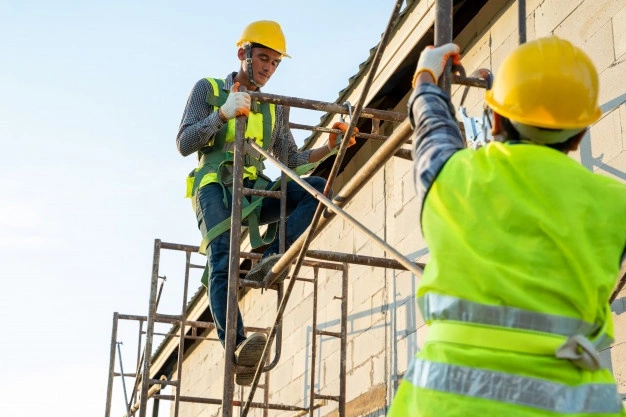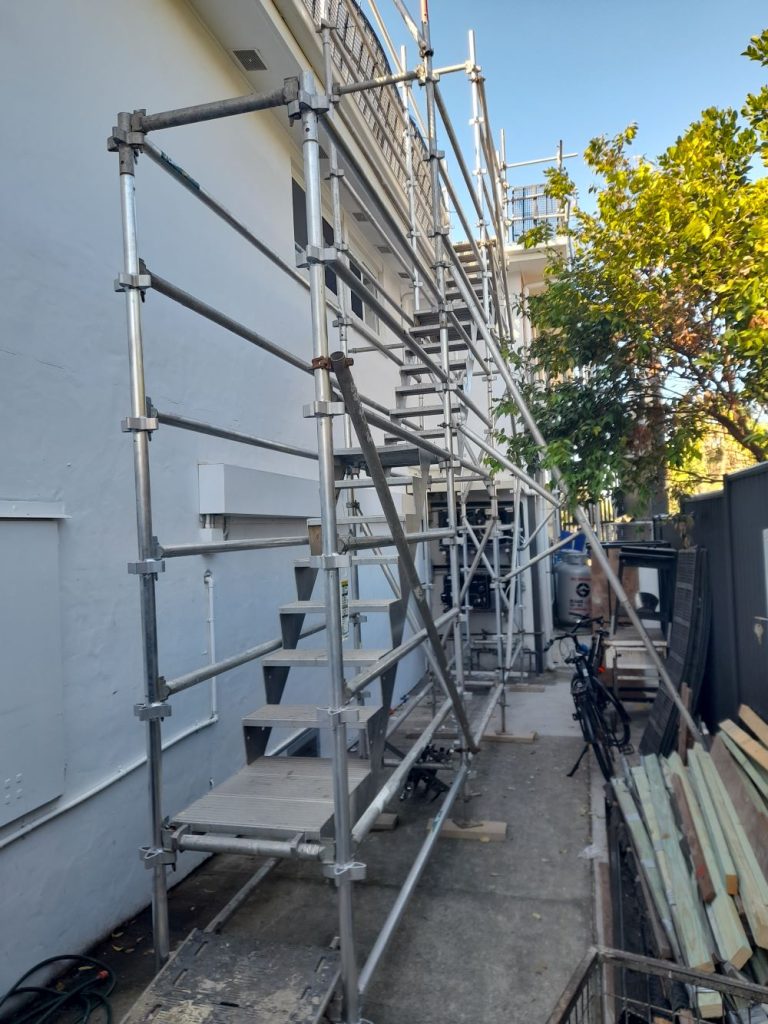If you have ever worked on or around scaffolding, you may have contemplated whether it's acceptable to place a ladder on top of it to reach elevated areas. This might seem like a quick and convenient solution, but before you reach for that ladder and start your ascent, there are several critical considerations to keep in mind.
While it may appear straightforward, employing a ladder atop scaffolding is EXCEEDINGLY hazardous. Introducing ANY extraneous items to an established scaffolding structure is ill-advised. The risks associated with this practice can be severe and should not be underestimated.
In this article, we will delve into the reasons why positioning a ladder on scaffolding is inadvisable and explore safer alternatives that can be employed instead.

Is It Safe to Use a Ladder on Scaffolding?
The unequivocal answer is NO; you should NOT use a ladder on scaffolding.
Utilising a ladder on scaffolding presents significant dangers. The purpose of scaffolding is to provide a safe and stable working platform that conforms to specific load-bearing specifications. When you add a ladder or any additional equipment, the entire structure's safety can be compromised, increasing the likelihood of accidents and injuries. Therefore, despite the allure of a seemingly clever shortcut, the potential risks far outweigh any perceived benefits.
Also Read: What NOT to do when using Scaffolding
The Risks of Using Ladders on Scaffolding
Having established that using a ladder on scaffolding is inadvisable, let’s examine the specific reasons why this practice is not safe:
1. Instability of the Scaffolding Structure
Scaffolding is meticulously designed to serve as a safe and robust working platform, but introducing a ladder disrupts this balance. Ladders are intended to be placed on solid ground, not atop another structure. When a ladder is positioned on scaffolding, it can destabilise the entire setup, increasing the risk of falls, slips, or even complete scaffold failure, which endangers everyone in the vicinity.
2. Increased Height Elevates Fall Risk
When working on scaffolding, you are already elevated above the ground. Adding a ladder can heighten this elevation, which in turn amplifies the risk of falling. The precariousness of using a ladder on scaffolding can lead to dangerous situations if the ladder shifts, slips, or fails to remain stable. The potential for severe injuries increases dramatically with higher falls.
Also Read: Who Is Responsible For The Scaffold Hire?
3. Improper Ladder Angle Compromises Safety
Ladders are designed for use at specific angles to ensure safety. Placing a ladder haphazardly on top of scaffolding prevents achieving the correct angle necessary for stability. A ladder that is improperly positioned is susceptible to slipping or sliding, particularly when installed on a surface that lacks solidity. Additionally, scaffolding does not afford the same level of support as a solid ground surface, making it challenging to secure the ladder at the appropriate angle.
4. Lack of Secure Attachment Poses a Significant Danger
Using a ladder on scaffolding often results in inadequate securing of the ladder. Most scaffolding setups are not designed to accommodate ladders, which means there is typically no reliable way to attach them securely. Although it may appear stable initially, movement, vibrations, or slips can quickly lead to the ladder falling or tipping over, posing a serious risk to users.
5. Violating OSHA Safety Regulations
If you are working on a construction site, adherence to safety regulations is likely mandated. The Occupational Safety and Health Administration (OSHA) enforces stringent guidelines regarding the use of scaffolding and ladders. Using a ladder on scaffolding inappropriately may result in violations of OSHA standards (e.g., 1926.1053 for ladders and 1926.451 for scaffolds). Such violations can lead to legal repercussions, fines, penalties, or even project shutdowns, making compliance with safety guidelines essential.
6. Certification Nullification Risks
Every scaffolding installation undergoes a certification process, ensuring that professionals have deemed it safe for use. Altering that setup by adding a ladder compromises the certification. In the event of an incident, you could find yourself without coverage regarding work health and safety regulations. Without the certification, you assume significant risk, which is an unacceptable gamble.
Safer Alternatives for Reaching Elevated Areas
Now that we have examined the reasons against using a ladder on scaffolding, let’s explore safer alternatives to achieve your desired height without compromising safety or breaching regulations:
Utilise Built-In Scaffold Access Solutions
Most scaffolding installations come equipped with built-in access features, such as ladders or stairways. These access points are specifically designed to ensure safety while navigating up and down the scaffolding. If your scaffolding includes these built-in options, take advantage of them! They are engineered to work seamlessly with the scaffolding system, enhancing overall security.

Consider Work Platforms or Extensions for Safer Access
Another viable alternative is to use a work platform or an extension. These solutions are specifically designed to provide a stable surface for working while offering safe access to higher levels. They present a more secure option than attempting to balance a ladder on scaffolding. Work platforms are robust and certified for use with scaffolding, ensuring your safety while facilitating the completion of tasks efficiently and effectively.
Final Thoughts on Ladder Use with Scaffolding
So, can you place a ladder on scaffolding?
The definitive answer is no! Utilizing a ladder on scaffolding can lead to structural instability, increase the risk of falls, and result in violations of safety regulations. The potential consequences simply do not justify the risks involved. Instead, make use of built-in scaffold access methods or opt for safer alternatives, such as work platforms. Always prioritise safety; the last thing you want is to jeopardise your well-being or that of others for the sake of convenience. Adhering to proper guidelines will keep you safe on the job.



This is such an important topic, and I appreciate you bringing attention to the dangers of using ladders on scaffolding! I remember a time when I was doing some home renovations and was tempted to use a ladder over scaffolding to reach some high spots. Thankfully, I did a bit of research first and realized just how risky that could be.
I’m glad you found it worthwhile to explore the risks of using ladders over scaffolding. It’s easy to underestimate those kinds of dangers, especially when we think we’re just doing a small home project. I had a similar moment when I was hanging up some lights on my porch. I almost reached for a ladder propped against the scaffolding, but then I remembered the research I had done about proper safety practices.
I really appreciated your insights on the dangers of using a ladder on scaffolding. It’s a topic that often doesn’t get the level of consideration it deserves! In my previous experience working in construction, we often found ourselves in the position of needing to reach elevated areas quickly, and I must admit, the temptation to just throw a ladder on the scaffolding was always there.
It’s a tricky balance, isn’t it? The need for speed in construction often clashes with safety protocols. I remember similar scenarios in my own work experience when we were under tight deadlines. The pressure to figure out a quick solution can really cloud judgment, but I think it’s crucial to remind ourselves about the potential risks involved with using a ladder on scaffolding.
This is a really important discussion you’ve initiated here. Working with scaffolding can sometimes create a false sense of security, especially when we’re tempted to improvise solutions like placing a ladder on it. I remember a project where we tried to reach an upper section quickly, but our supervisor wisely stepped in and reminded us about the risks.
Oh boy, ladders and scaffolding—a dynamic duo that could really elevate (pun intended) a construction site disaster! I remember a time when I was helping a friend with a DIY project that involved both. We were on a small scaffold, and my friend, in an attempt to reach that one elusive corner of the ceiling that clearly needed more paint, decided that propping a flimsy ladder atop the scaffolding was the way to go. It was like watching a comedy unfold in slow motion.
I appreciate how you’ve highlighted the dangers of using a ladder on scaffolding. It’s such a common temptation to think that adding a ladder might make our work easier or quicker, but it really does introduce a whole new set of risks.
I appreciate your clear stance on the hazards of using a ladder on scaffolding. It’s an issue that many might overlook, especially in high-pressure work settings where speed is often prioritized over safety. I’ve seen firsthand how this kind of convenience-seeking can lead to dangerous situations. A colleague of mine once placed a ladder on scaffolding to reach a higher area quickly, thinking it would save time. Fortunately, nothing serious happened, but it was a sobering reminder of how easily accidents can occur when we don’t adhere to safety protocols.
Your article raises a crucial point about safety protocols that often seem overlooked in the rush to complete projects quickly and efficiently. I can’t help but share my own experience that ties into this discussion. A few years ago, while working on a construction site, I witnessed a co-worker place a ladder on scaffolding to access a hard-to-reach area. At the time, it looked like a pragmatic solution to avoid extra labor, but as they climbed higher, it became increasingly clear just how precarious that situation was.